 W
WJulida is an order of millipedes. Members are mostly small and cylindrical, typically ranging from 10–120 millimetres (0.39–4.72 in) in length. Eyes may be present or absent, and in mature males of many species, the first pair of legs is modified into hook-like structures. Additionally, both pairs of legs on the 7th body segment of males are modified into gonopods.
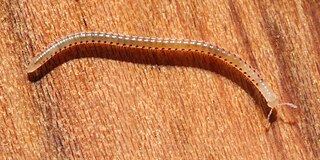 W
WBlaniulidae is a family of millipedes in the order Julida. Members are long and thin, with a length:width ratio of up to 30:1. Eyes may be present or absent, and members have distinctive spots on each segment: the ozadenes or odiferous glands. The family contains the following genera:
 W
WBlaniulus is a genus of millipedes containing the following species:
 W
WBlaniulus guttulatus, commonly known as the spotted snake millipede is a species of millipede in the family Blaniulidae that can be found in Central and Western Europe. It has been introduced in North American countries such as the United States, Canada, Saint Helena, and Tristan da Cunha, as well as Tasmania and Norfolk Island, Australia.
 W
WBrachyiulus is a genus of millipedes, containing around eight species, most of which live in the Mediterranean Basin of Europe and Asia. The species B. pusillus has been introduced widely around the world
 W
WBrachyiulus pusillus is a species of millipede in the family Julidae. It is widespread in Europe and has also been introduced to islands around the world, continental South America, South Africa, and Oceania, and is potentially widespread in North America, although previous records may have confused B. pusilus with the related B. lusitanus. The species is brownish-black coloured and has 30–34 segments. They also have either light yellowish or reddish lines that are located closer to the centre of the back. It can be found on bushes and trees. The species are commonly found in walls or fences.
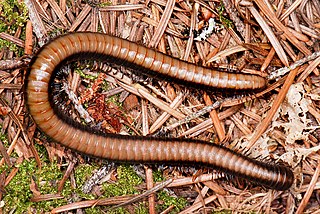 W
WCaliforniulus is a genus of cylindrical millipedes containing six species native to the western United States.
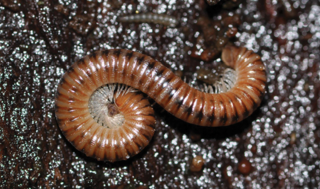 W
WCylindroiulus is a genus of millipedes of the Julidae family.
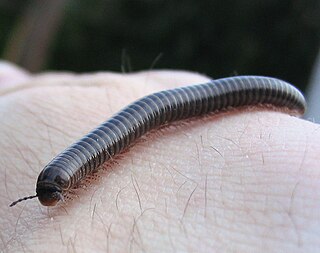 W
WCylindroiulus caeruleocinctus is a species of millipede in the family Julidae.
 W
WJulidae is a family of millipedes in the order Julida, containing more than 600 species in around 20 genera. Its members are largely confined to the Western Palaearctic, with only a few species extending into the Oriental and Afrotropical realms. They are united by a characteristic form of the mouthparts, and are classified in the superfamily Juloidea of the order Julida, alongside the families Trichoblaniulidae, Rhopaloiulidae and Trichonemasomatidae.
 W
WJulus is a genus of millipedes in the family Julidae, containing the following species:
 W
WJulus scandinavius is a species of millipede from Julidae family. It was described by Latzel in 1884 and is found in Austria, Benelux, Czech Republic, France, Germany, Hungary, Ireland, Poland, Slovakia, Switzerland, Britain I. and Scandinavia.
 W
WMammamia profuga is a species of cave-dwelling millipede in the family Julidae. The only known species of the genus Mammamia, it was described in 2011 from a specimen discovered in a cave in Italy.
 W
WMegaphyllum unilineatum is a species of millipede in the family Julidae, first described by Carl Ludwig Koch in 1838. No subspecies are listed in the Catalogue of Life.
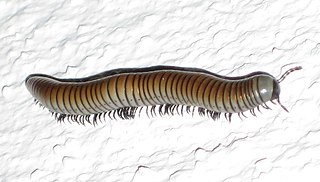 W
WOmmatoiulus is a genus of millipedes in the family Julidae.
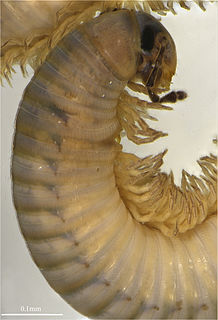 W
WOmmatoiulus avatar is a species of European millipede in the family Julidae. Individuals are known from Andalusia, southern Spain. Individuals are 25 to 38 mm long. Color in alcohol preserved specimens is brownish with yellowish and black marbling on the dorsal surface. O. avatar was described in 2015, with the aid of X-ray microtomography that produced a three-dimensional digital model, becoming the first millipede described from reference to physical type specimens as well as virtual models, known as "cybertypes".
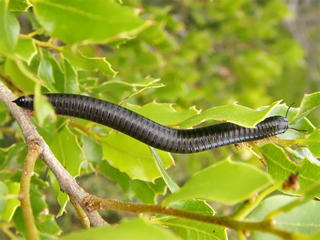 W
WOmmatoiulus moreleti, commonly known as the Portuguese millipede, is a herbivorous millipede native to the southern Iberian Peninsula where it shares its range with other Ommatoiulus species. From here, it has spread by international commerce to a number of new localities. This species was accidentally introduced into Australia without its natural enemies and has since become an invasive pest. A number of methods have been developed to manage this millipede.
 W
WOmmatoiulus sabulosus, also known as the striped millipede, is a European millipede of the family Julidae. Its common name comes from its two striking bright longitudinal bands on the dorsal surface.
 W
WOmmatoiulus sabulosus aimatopodus is a millipede occurring in the South of France; belonging to the same species than Ommatoiulus sabulosus, it differs from the type by the lack of lighter transversal lines on the back when adult. It is believed to be a Mediterranean-climate adapted variant, but whether it is a true subspecies or rather an ecomorph is unclear; first described by Antoine Risso as a distinct species, it is for now considered as a form of Ommatoiulus sabulosus, under the name Ommatoiulus sabulosus f. aimatopodus.
 W
WOphyiulus is a genus of millipedes in the family Julidae. There are more than 30 described species in Ophyiulus.
 W
WOphyiulus pilosus is a species of millipede in the family Julidae. It is found in North America.
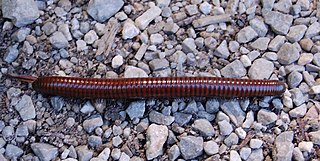 W
WPachyiulus is a genus of julid millipedes containing the following species:
 W
WPachyiulus hungaricus is a species of millipede from Julidae family that can be found in Albania, Bulgaria, Greece, Romania, and all states of former Yugoslavia.
 W
WPaeromopodidae is a family of large cylindrical millipedes of the order Julida native to the western United States of America. The family contains two genera and ten species and includes the longest millipedes in North America, with individuals reaching up to 16.5 cm (6.5 in) long.
 W
WPaeromopus is a genus of large cylindrical millipedes endemic to the U.S. state of California. All species exceed 10 centimeters in length, and the largest, P. paniculus, reaching 16.5 cm is the longest millipede species in North America. The genus was named by German entomologist Ferdinand Karsch in 1881 and contains four species: three occupying small ranges in the Sierra Nevada mountains and one occupying a large range including the Sierra Nevada and much of Northern California to the Central Coast.
 W
WPaeromopus angusticeps is a species of millipede found in the U.S. state of California. It occupies the largest geographic range of all four species of Paeromopus, occupying much of Northern California in a large arc extending from Monterey County on the central coast, north along the Coast Ranges to Humboldt County, and descending along the Cascades and Sierra Nevada range of eastern California. P. angusticeps is largely absent from California's Central Valley.
 W
WParajulidae is a family of millipedes in the order Julida, occurring predominantly in North America but also in Central America and East Asia. Parajulids occur in Alaska, and the continental United States as well as bordering Canadian provinces, and as far south as Guatemala. Male Parajulids have a greatly enlarged first pair of legs, and externally exposed gonopods, in contrast to the largely Eurasian family Julidae which have a small, hook-shaped first pair of legs, and gonopods concealed internally.
 W
WProteroiulus is a genus of millipedes in the family Blaniulidae, containing the following species:Proteroiulus broelemanni Lohmander, 1925 Proteroiulus fuscus (Am Stein, 1857) Proteroiulus hispanus Schubart, 1959
 W
WProteroiulus fuscus is a species of millipede in the family Blaniulidae which can be found everywhere in Europe except for Albania, Andorra, Liechtenstein, Moldova, Monaco, Romania, San Marino, Vatican City, all states of former Yugoslavia and some European islands.
 W
WTachypodoiulus is a genus of millipedes in the family Julidae which contains three species.
 W
WTachypodoiulus niger, known variously as the white-legged snake millipede or the black millipede, is a European species of millipede. It is very similar to other species such as Cylindroiulus londinensis, from which it can be reliably distinguished only by studying the shape of the telson. It occurs in Ireland, Britain, Spain, France, Benelux, Germany, Switzerland, Austria and the Czech Republic, and is especially common on chalky and limestone soils.
 W
WTitanophyllum spiliarum is a species of cave-dwelling millipede in the family Julidae. The only known species of the genus Titanophyllum, it was described in 2011 from specimens discovered in a cave in Greece. It has several unusual characteristics including eyelessness and a small hook on its hind-most body section that may be involved in keeping the animal ‘locked’ when it coils-up defensively.